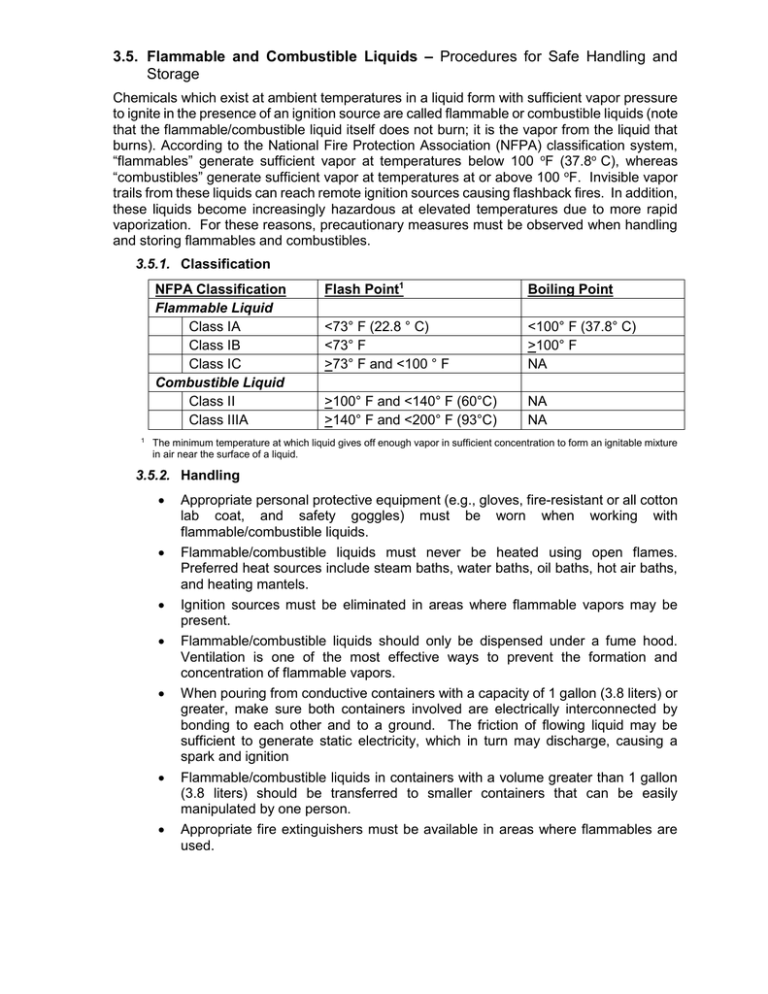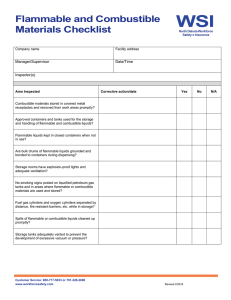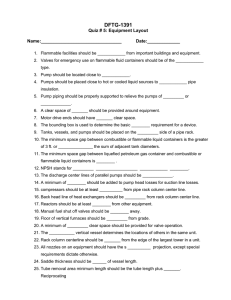Flammable and Combustible Liquids – Procedures for
advertisement

3.5. Flammable and Combustible Liquids – Procedures for Safe Handling and Storage Chemicals which exist at ambient temperatures in a liquid form with sufficient vapor pressure to ignite in the presence of an ignition source are called flammable or combustible liquids (note that the flammable/combustible liquid itself does not burn; it is the vapor from the liquid that burns). According to the National Fire Protection Association (NFPA) classification system, “flammables” generate sufficient vapor at temperatures below 100 oF (37.8o C), whereas “combustibles” generate sufficient vapor at temperatures at or above 100 oF. Invisible vapor trails from these liquids can reach remote ignition sources causing flashback fires. In addition, these liquids become increasingly hazardous at elevated temperatures due to more rapid vaporization. For these reasons, precautionary measures must be observed when handling and storing flammables and combustibles. 3.5.1. Classification NFPA Classification Flammable Liquid Class IA Class IB Class IC Combustible Liquid Class II Class IIIA 1 Flash Point1 Boiling Point <73° F (22.8 ° C) <73° F >73° F and <100 ° F <100° F (37.8° C) >100° F NA >100° F and <140° F (60°C) >140° F and <200° F (93°C) NA NA The minimum temperature at which liquid gives off enough vapor in sufficient concentration to form an ignitable mixture in air near the surface of a liquid. 3.5.2. Handling Appropriate personal protective equipment (e.g., gloves, fire-resistant or all cotton lab coat, and safety goggles) must be worn when working with flammable/combustible liquids. Flammable/combustible liquids must never be heated using open flames. Preferred heat sources include steam baths, water baths, oil baths, hot air baths, and heating mantels. Ignition sources must be eliminated in areas where flammable vapors may be present. Flammable/combustible liquids should only be dispensed under a fume hood. Ventilation is one of the most effective ways to prevent the formation and concentration of flammable vapors. When pouring from conductive containers with a capacity of 1 gallon (3.8 liters) or greater, make sure both containers involved are electrically interconnected by bonding to each other and to a ground. The friction of flowing liquid may be sufficient to generate static electricity, which in turn may discharge, causing a spark and ignition Flammable/combustible liquids in containers with a volume greater than 1 gallon (3.8 liters) should be transferred to smaller containers that can be easily manipulated by one person. Appropriate fire extinguishers must be available in areas where flammables are used. 3.5.3. Storage Flammable/combustible liquid in quantities exceeding a total of 10 gallons (38 liters) within a laboratory must be stored in approved flammable storage cabinets or safety cans. Flammable/combustible liquid stored outside of flammable storage cabinets in the laboratory should be kept to the minimum necessary for the work being done. Containers with a volume greater than 5 gallons (19 liters) shall not be stored in the laboratory without prior approval of IUEHS for the respective campus. Flammable/combustible liquid stored in glass containers shall not exceed 1 gallon (3.8 liters). Flammable storage cabinets and safety cans must not be altered or modified. Safety cans with damaged screens (spark arrestors) or faulty springs (that do not close tightly) do not meet the required specifications of a safety can and must be taken out of service immediately and repaired or replaced. Flammable liquids must only be stored in explosion-proof or laboratory-safe refrigeration equipment. Flammable/combustible liquid containers, filled or empty, must not be stored in hallways or obstructing exits. Bulk waste flammable/combustible liquids should be stored in safety cans. Flammables and combustibles must not be stored near oxidizers, corrosives, combustible material, or near heat sources. Make sure all chemicals stored near flammables and combustibles are compatible.


